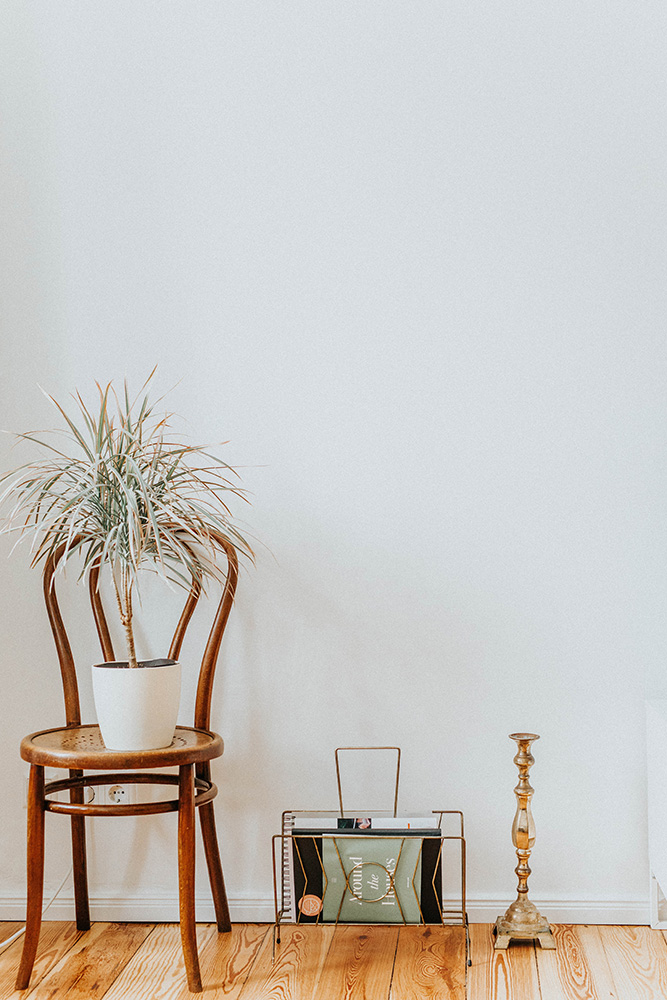


Though indoor plants on Pinterest have helped us reach a maximum level of cozy, keeping them alive in the winter can be frightening. The change in season means tending to your plants in an entirely new way. Below we’ve rounded up some tips on how to keep your indoor plants alive and well during these tempermantal times.
1. Adjust Watering Schedules
Though winter air is drier, plants experience a slower rate of growth during these months. Meaning, your indoor plants will require less water and if you over water, it can lead them to rot. Just because the surface of the soil is dry doesn’t necessarily mean the rest of your plant is dry. Make sure to stick your finger into the soil and check to see if it’s dry 1-2 inches below the surface. If it is, then you’ll want to water it about the same temperature as the air to avoid shocking your plant. Some drought tolerant plants include succulents and cacti.
2. Increase Humidity
Low humidity in the air can be a big contender for why plants die in the winter. If you have a humidifier in your home, move it closer to your plant(s). If you don’t own a humidifier, you can try putting your plants closer together due to the fact that they naturally release water through their leaves. By grouping them together you’ll put their moisture to good use.
3. Stabilize Temperatures
Just like people, plants don’t like extreme changes and that doesn’t exclude temperatures. Be sure to move them away from open windows, doors, and heating units. They are comfortable in daytime temperatures between 65-75 degrees Fahrenheit and at night, keep temperatures above 50 degrees Fahrenheit. Fluctuations in temperature can be deadly to houseplants.
4. Follow the Sun
Not only is there less sunlight during the winter months, it comes in at a lower angle. Because of this, you may need to move your plants to a brighter area in the house, or even add external lighting. Start by facing your plants in a south or west facing window that remains sunny or bright all day.
5. Ditch the Fertilizer
Because your plants are barely growing, they don’t need fertilizer. Feeding them will agitate their natural cycle so be sure to hold off until early spring. When you see new signs of growth, or green on the existing leaves you can resume fertilizing.
6. Dust, Dust, Dust
Homes can easily get stuffy during this time of year from the lack of fresh air entering the space. When it’s cold outside, it’s unlikely that you’ll want to open a window. And because of this, your space is more prone to dust. Dust buildup on your window or plants will reduce the amount of light getting to your plant. And because they’re receiving significantly less light this interference can be fatal.
7. Don’t Freak Out
When you see your plants’ leaves on the ground don’t completely freak out (easier said than done). It doesn’t necessarily mean it’s the end of their life. Plants will often drop their leaves to compensate for the lack of light, food, and water they’re getting. It’s normal for a plant to look lackluster than it did compared to the summer months. Trimming can help prevent further leaf loss.
Pinterestなどで共有される屋内植物は、自宅を最高に居心地のよい環境にするのに役立っていますが、それらを冬の間も生き生きとさせておくのは恐ろしく大変なことです。 季節の変化は、植物に対しての接し方がまったく変わる事を意味します。 以下に、これらの不穏な時期に屋内植物を元気に保つ方法に関する、いくつかのヒントをまとめました。
1. 水やりスケジュールを調整する。
冬の空気はとても乾燥していて、これらの時期は植物の成長速度が遅くなります。 つまり、屋内の植物は水をあまり必要とせず、過度に水を与えると腐敗する可能性があります。 土壌の表面が乾燥しているからといって、必ずしも植物全体が乾燥しているわけではありません。 必ず指を土に刺して、表面から1〜2インチ乾燥しているかどうかを確認してください。 もしそのような状態であれば、植物にショックを与えないように、気温とほぼ同じ温度の水をやりましょう。 乾きに強い植物として、多肉植物やサボテンがあります。
2. 湿度を上げる。
空気中の湿度が低いことは、植物が冬に枯れてしまう大きな原因となります。 家に加湿器がある場合は、植物に近い場所に置いてください。 加湿器がない場合は、植物同士を近づけてみてください。 通常植物は葉から水分を放出するため、植物同士をくっつけて配置する事で、放出する水分をお互いに有効活用できます。
3. 温度を安定させる。
植物も人間と同じように、極端な変化を好みません。 開いている窓やドア、暖房器具の近くには置かないでください。 昼間は華氏65〜75度(摂氏約18~24度)、夜は華氏50度(摂氏約10度)以上の温度に保ちましょう。 温度の変動は、観葉植物にとって致命的です。
4. 日光に従う。
冬の間は日光が少ないだけでなく、より低い角度で射し込みます。 このため、植物を家の明るい場所に移動したり、外部照明を追加したりする必要があります。 南または西向きの窓に向けて植物を配置します。こうすることで、太陽の光や熱をとりいれることが出来るのです。
5. 肥料を処分する。
この時期に植物はほとんど成長していないため、肥料は必要ありません。栄養を与えすぎると自然のサイクルが乱れるので、春先まで待ってください。 新しい成長の兆候、または既存の葉の緑色が色濃く現れたら、肥料を再開できます。
6. ほこり、ほこり、ほこり
この時期は、家の中に新鮮な空気が入らないため、家の中は息苦しくなります。 外が寒いときは、窓を開けたくなくなるでしょう。このため、あなたの部屋はより塵に埋もれやすくなり、窓や植物にほこりが溜まりがちになります。すると植物に届く光の量が減り、受けられる日光が著しく少なくなるため、時にはそれが致命傷になる事があります。
7. パニックにおちいらないで。
葉っぱが地面に落ちているのを見ても、パニックに陥らないでください。 必ずしも彼らの人生の終わりを意味するわけではありません。 植物はしばしば葉を落として、光、食物、水の不足を補います。 植物が夏の数ヶ月に比べて見栄えがよくないのは普通のことです。 トリミングは、さらなる葉の損失を防ぐのに役立ちます。